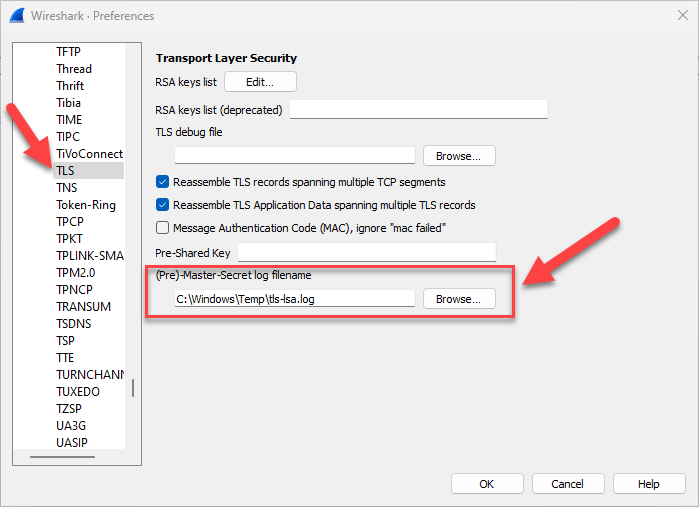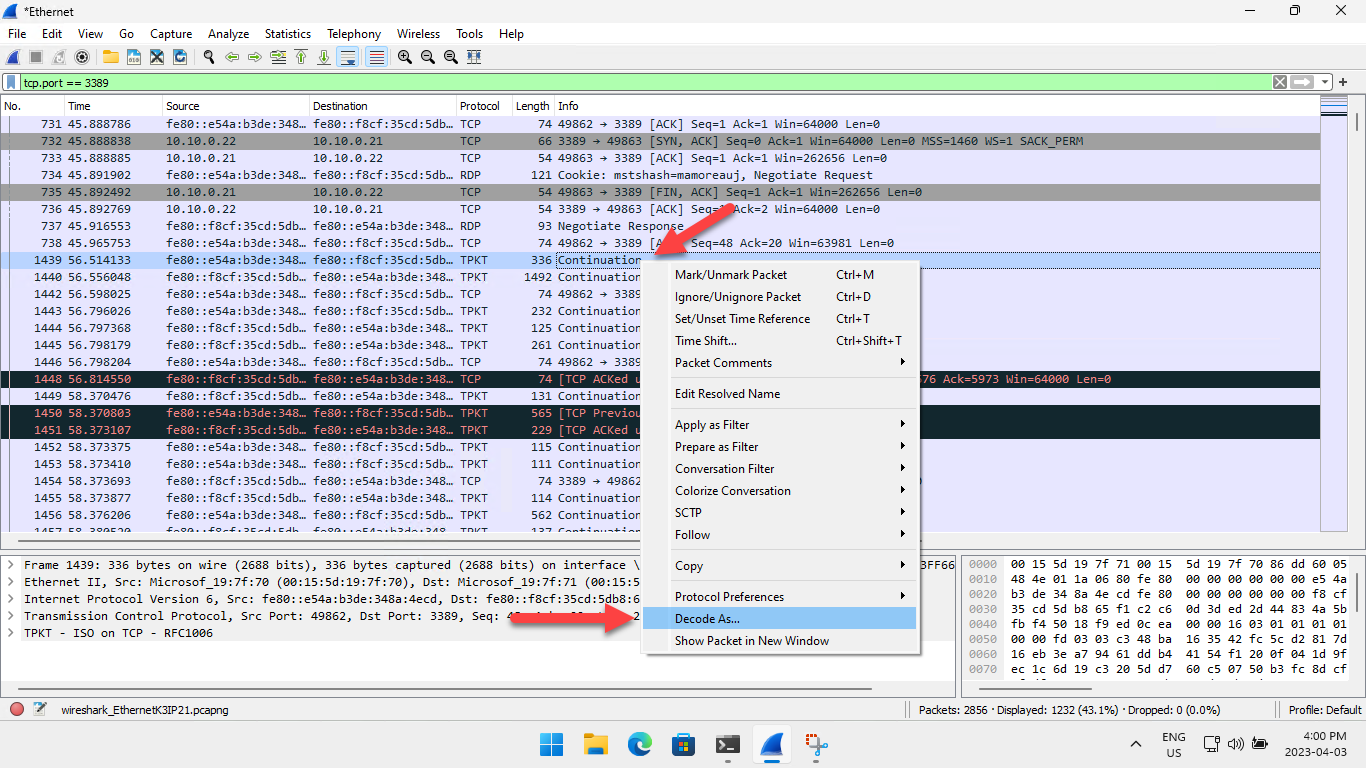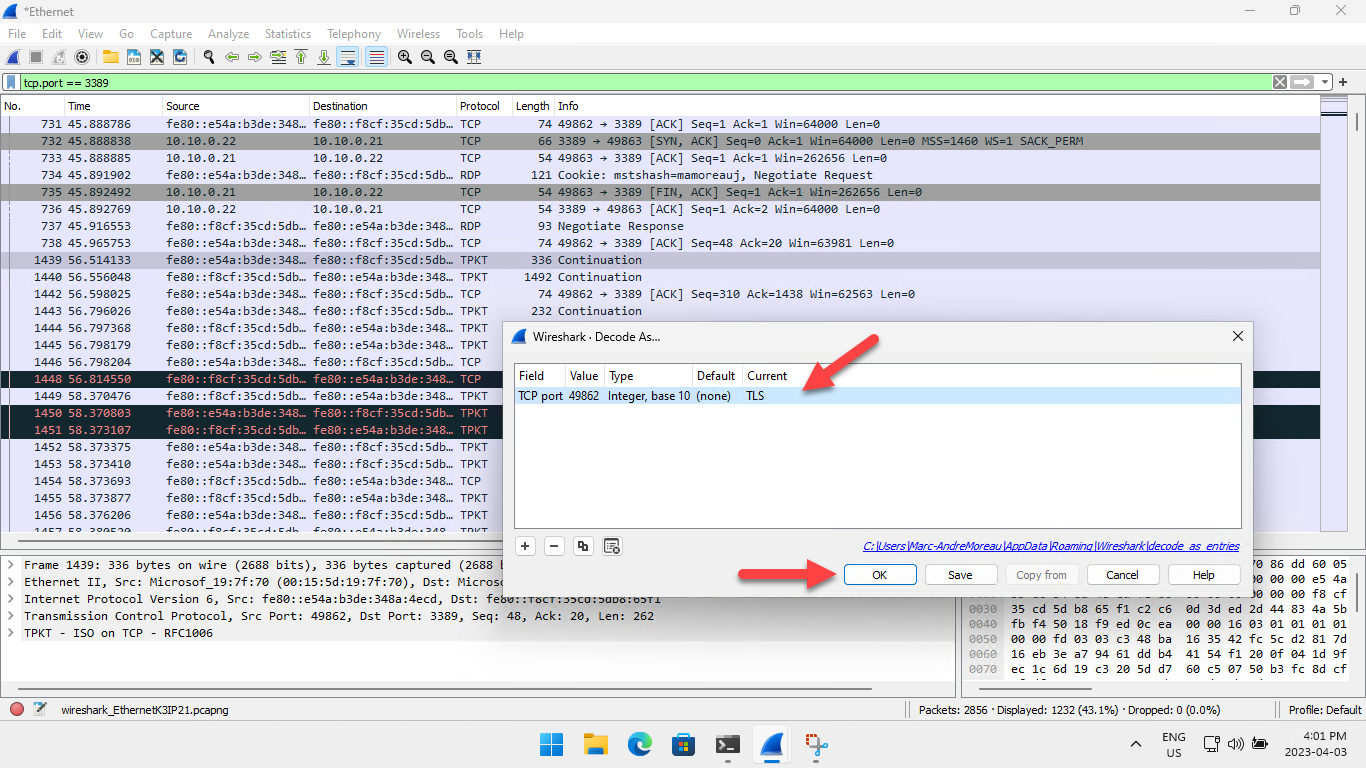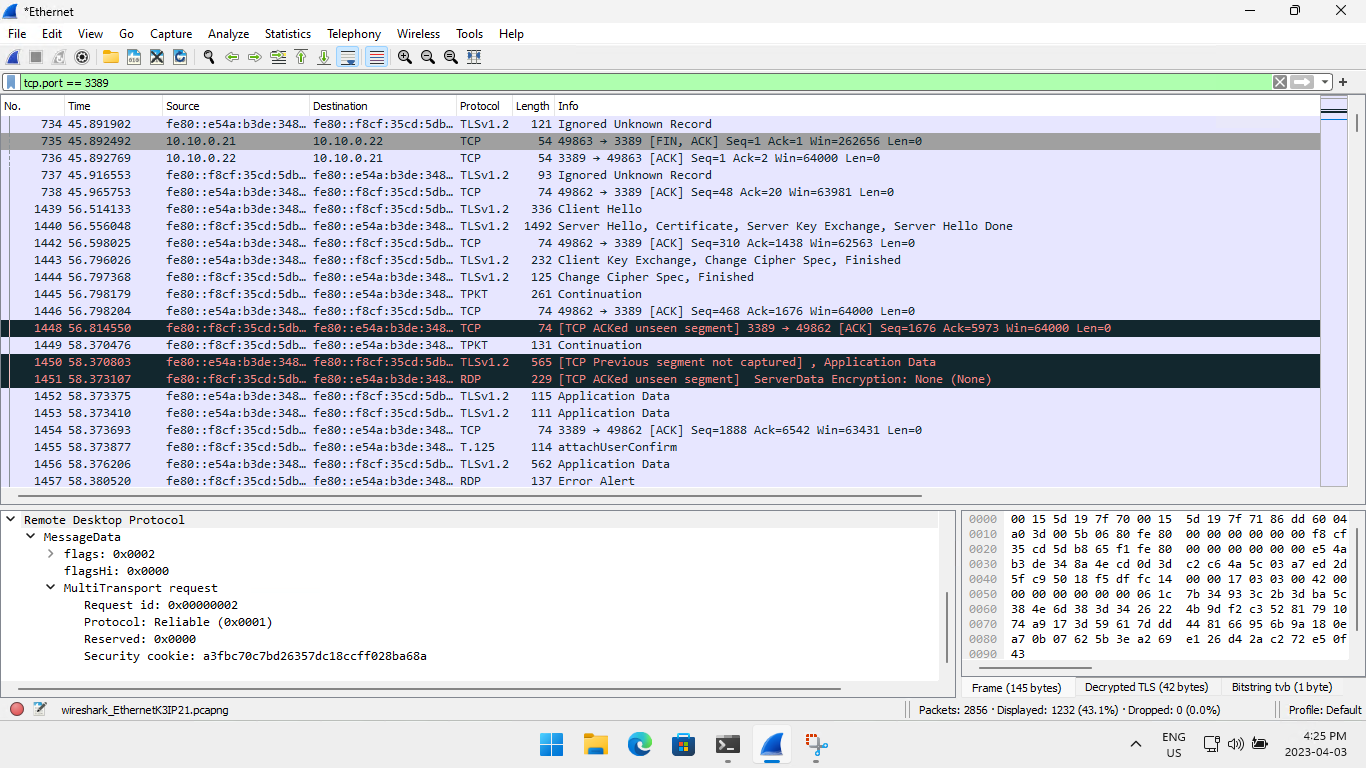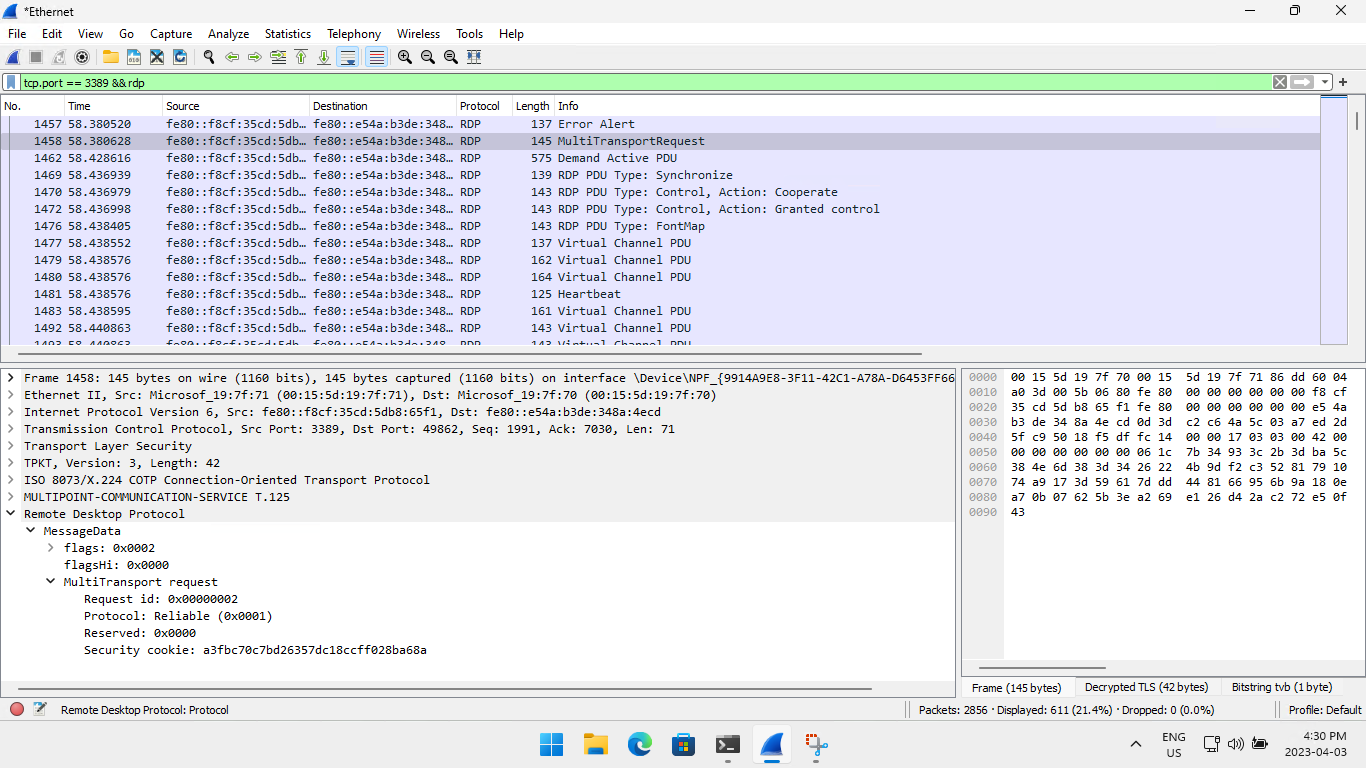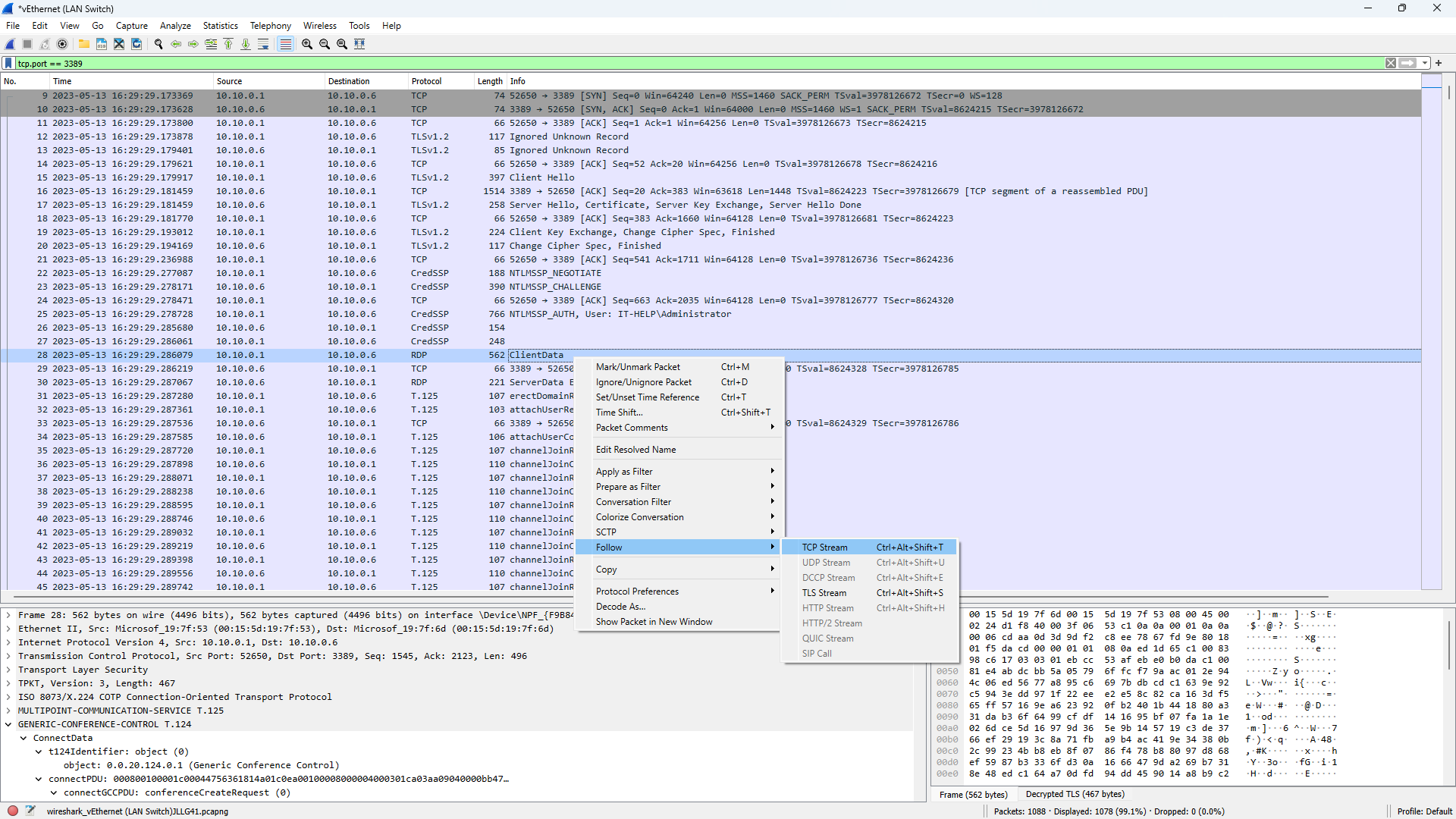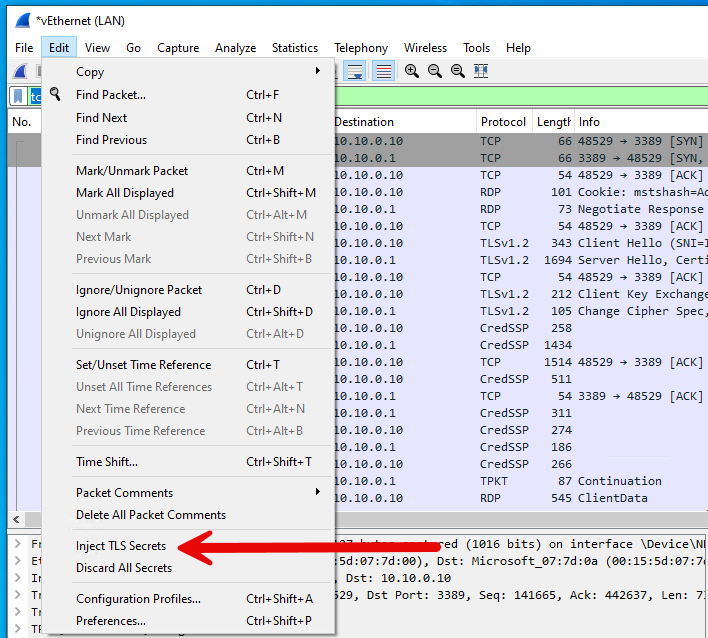Looking for a way to capture and inspect RDP traffic in Wireshark? You've come to the right place!
Many applications, including browsers, support the SSLKEYLOGFILE environment variable with a path to a text file where TLS pre-master secrets are dumped. This format is supported by Wireshark and does not require exporting server private keys.
To configure Wireshark to use a specific TLS key log file, open the Preferences dialog (Edit -> Preferences), navigate to the TLS section under Protocols, and then change the (Pre)-Master-Secret log filename field:
This technique involves attaching to lsass.exe in order to dump TLS pre-master secrets from SChannel into the SSLKEYLOGFILE format supported by Wireshark. This is by far the simplest approach so it's absolutely worth the trouble, but it should only be used in test environments where security features can be disabled.
Follow these instructions using an elevated PowerShell 7 terminal (Windows PowerShell is not compatible).
Disable LSA extended protection, and then reboot the machine:
Set-ItemProperty -Path 'HKLM:\SYSTEM\CurrentControlSet\Control\Lsa' -Name 'RunAsPPL' -Value 0Install PSDetour:
Install-Module -Name PSDetour -Scope AllUsers -ForceLaunch tls-lsa-dump.ps1:
.\tls-lsa-dump.ps1By default, the script will use C:\Windows\Temp\tls-lsa.log as the SSLKEYLOGFILE. Make sure that Wireshark is properly configured to use it, then capture a first RDP connection to see if it works!
You thought this was the end of it? Not so fast!
Wireshark associates TCP/3389 with the TPKT dissector by default, which works for the X.224 connection request/confirm packets that happen before the TLS handshake.
For some reason, the TPKT dissector often won't handoff the TLS packets to the TLS dissector, causing the 'TPKT Continuation' issue. When this happens, right-click on one of the RDP packets, then select **Decode As...":
In the Wireshark Decode As.. dialog, change the default or current dissector to TLS then click OK:
With the TLS dissector forced on the entire TCP connection, the X.224 packets will show up as 'Ignored Unknown Record', but you should now be able to see the TLS handshake, and hopefully some RDP decrypted packets!
To get a cleaner view of the RDP traffic without TCP and TLS packets, add "rdp" to the current Wireshark filter.
Some RDP features can make packet captures messy and harder to analyze, some Windows features can create unwanted background noise, requiring more advanced filtering to keep only the relevant traffic.
Unless you intend to work on the RDP UDP protocol itself, I highly recommend disabling RDP UDP to get a single, clean RDP TCP connection:
Set-ItemProperty -Path 'HKLM:\SOFTWARE\Policies\Microsoft\Windows NT\Terminal Services\Client' -Name 'fClientDisableUDP' -Value 1Even if you block RDP UDP traffic in the firewall, you will still get some noise from the RDP multitransport extension over the primary RDP TCP connection.
Bandwidth auto-detection is VERY noisy at the beginning of an RDP connection - disable it at all costs in your .RDP file:
connection type:i:6
networkautodetect:i:0
bandwidthautodetect:i:0
Network auto-detection is connection type 7 (auto-detect), which is when bandwidth auto-detection would kick in. This is why disabling the feature completely is best done by setting an explicit network type (6 for LAN), and then disabling both network and bandwidth auto-detection. If you're confused, you're not alone.
RDP bulk data compression is great everywhere except when you want to inspect the packets. Disable compression by adding compression:i:0 to your .RDP file:
compression:i:0
If you're inspecting HTTP traffic alongside the RDP connection (think Azure AD, Azure Virtual Desktop, RD Gateway, etc) then you'll want to remove some of the background noise by disabling SmartScreen:
Set-ItemProperty -Path 'HKLM:\SOFTWARE\Policies\Microsoft\Windows\System' -Name 'EnableSmartScreen' -Type DWORD -Value 0Don't forget to close unused browsers, and Windows should be quiet enough!
The latest version of FreeRDP accepts SSKEYLOGFILE as a command-line parameter:
/tls:secrets-file:</path/to/freerdp-tls.keys>
It is recommended to build FreeRDP from source, as prebuilt versions of FreeRDP in Linux distributions are unlikely to have this option.
The IronRDP desktop client accepts the SSKEYLOGFILE environment variable:
$Env:SSLKEYLOGFILE="C:\path\to\ironrdp-tls.keys"IronRDP is still in active development, so check for updates frequently!
Make sure you have correctly set up Wireshark with a TLS pre-master secret file used by the RDP client you wan to capture traffic from. Start the capture, launch a connection, then stop the capture. Apply a simple filter like tcp.port == 3389, then right-click on any of the RDP packets and use Follow -> TCP Stream:
Wireshark should now show only a single RDP TCP connection with TLS traffic decrypted, and all unrelated traffic removed.
Next, use Edit -> Inject TLS Secrets to inject the TLS secrets from the currently loaded TLS pre-master secret file into the capture file:
Export the filtered, decrypted capture using File -> Export Specified Packets... In the export dialog, select Displayed instead of Captured, and save the capture in the newer pcapng format, not the older pcap format (very important!).
Alternatively, you can inject TLS secrets into an existing .pcapng file using the editcap command-line tool:
$CaptureName = "rdp-test" # change this
$Env:PATH += ";$Env:ProgramFiles\Wireshark"
& editcap --inject-secrets "tls,${CaptureName}.keys" "${CaptureName}.pcapng" "${CaptureName}-tls.pcapng"
@("${CaptureName}.pcapng", "${CaptureName}.keys") | Remove-Item
Move-Item "${CaptureName}-tls.pcapng" "${CaptureName}.pcapng"Congratulations, you now have a Wireshark capture file with RDP traffic that you can easily share with anyone and that will decrypt properly!
Sample Wireshark capture files are available here!
